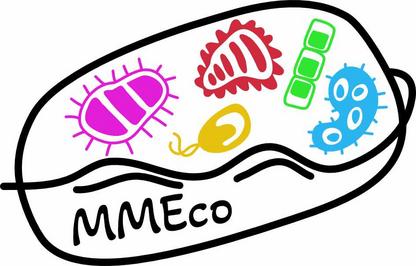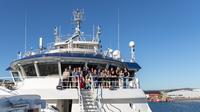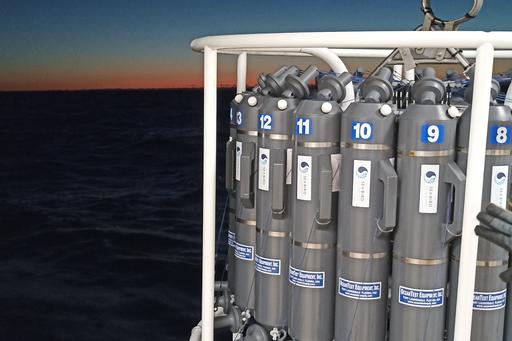Marine Microbial Ecology Group – MMEco
Short description
We study the microbes of the sea. How do they interact with other microbial organisms? Which roles and functions do microbes have in the ocean? To learn about microorganisms, we use lab and field experiments, join research expeditions, and conduct bioinformatic analyses.
About us
Our goal is to generate a better understanding of marine microbial ecology and to fill existing knowledge gaps. We want to generate interest and excitement about marine microbes and communicate the importance of these tiny organisms.
As a group, we comply with best scientific practices and work to the best of our abilities in a professional manner. We strive to achieve this by conducting fair and ethical science, while working in a supportive and inclusive environment where new ideas and perspectives are welcomed and valued, and where we act with responsibility, respect each other’s time, and hold ourselves accountable.
We welcome enthusiastic students, visiting PhD students, and postdocs to join our group! If you are interested in learning more about our research, please contact Carina Bunse directly.
Researchers
Carina Bunse, Associate Senior Lecturer at the Department of Marine Sciences
Nicolai Laufer, PhD student at the Department of Marine Sciences
Teresa Peil, PhD student at the Department of Marine Sciences
Alisa Wüst, PhD student at the Department of Marine Sciences
Olga Kourtchenko, Principal Research Engineer at the Department of Marine Sciences


MMEco Highlights
Field work in Costa Rica
The new year started with a great adventure to Costa Rica for our PhD student Alisa Wüst. She conducted fieldwork to enhance our understanding of the different modules of denitrification. On a small research vessel, she and her colleagues collected water samples with hand-operated Niskin casts in the Golfo Dulce, a fjord-like system with stable oxygen depletion.
The collected water was incubated at the nearby research station where local dogs visited regularly. On a lucky day, they could even spot exotic birds like toucans and parrots or encounter a water snake while sampling.
Networking about microbial ecology
To study microbial interactions efficiently, also we researchers need to connect and communicate with peers. Therefore, we participated in several meetings and conferences this year. Amongst them, the AMRI meeting in Uppsala, M2C2 and SAME18 conferences, and we organized the 2025 Swedish Marine Research days in Gothenburg. Across the meetings, Nicolai presented his AquaTS project, sharing results from the first eight months of the time series. Teresa presented her recent work on growth experiments with microbial synthetic communities. Olga showed fantastic phytoplankton pictures and results from our summer cruise that were taken with the PlanktoScope. Carina presented results from co-culture experiments with marine Roseobacters. Overall, these were exciting scientific programs on aquatic microbiomes on a changing planet and the conferences brought together leading researchers to discuss the latest advances in aquatic microbial ecology.
Also, we hosted a PhD course in Microbial Oceanography in Kristineberg this June. 14 PhD students from Swedish and German research institutions participated this 10-day course and learned about marine bacteria, fungi, archaea, viruses and phytoplankton – from surface waters to the deep biosphere. The international team of teachers, enthusiastic students, fantastic weather, and exciting topics made this course a great success.
SWE25 cruise
In beginning of July 2025 our group went on an eight-day research cruise along the Swedish West coast on RV SVEA funded by SWERVE. We joined 15 aquatic microbiologists from Swedish and Spanish universities. The cruise started in Lysekil from where we went northwards nearshore to Idefjorden, before we traveled offshore back to Lysekil.
The aim of our project - EcoAct - was to assess the microbial biodiversity collected from coastal and offshore stations via eDNA. In addition, we conducted in-depth studies of marine Actinomycetes, measured ecophysiological rates in microcosm incubations along environmental gradients, and assessed metabolite-mediated interactions between marine microorganisms in this region.
More news articles about the cruise can be found here:


Ongoing projects
Hidden microbial biodiversity
Traditionally, marine microbial community composition and gene expression are known to be impacted by temperature, albeit it is still unknown how this affects specific community assembly and interactions. For this study, PhD student Nicolai Verbücheln implemented a microbial time-series using aquaria tanks as a model system.
Aquarium systems are designed to mimic natural environments as closely as possible while providing a controlled system with a reduction in complexity and biodiversity compared to natural ecosystems. In collaboration with the Maritime Museum Aquarium in Gothenburg, we have sampled the bacterial biodiversity of four aquaria (two tropical and two temperate systems) for 1.5 years. We will compare the microbial biodiversity to Nordic marine environments and other aquaria. Our findings help us to explain the long-term structural and functional community dynamics that we observe in natural marine microbial communities but struggle to understand due to the high complexity of natural ecosystems. This will facilitate our ability to predict how microbes and their provision of essential ecosystem services will be affected by events such as global warming.
This project is funded by Kungl. Vetenskapsakademiens stiftelser and the Carl Tryggers foundation.


Marine prokaryotes, keystone populations in the changing ocean (2025-2028)
Marine prokaryotes (bacteria and archaea) play a critical role in the turnover of organic carbon in the microbial cycle, influencing the amount of carbon stored in the ocean or removed from long-term storage by respiration.
Research on ocean change often overlooks microorganisms, and there is no consensus on the effects of climate change on marine microorganisms, yet it is important to understand how they cope with and contribute to changing oceans. In this project, we will investigate which microbes contribute to the turnover of organic carbon in different ocean regions and temperatures.
The results will help us understand the link between microbial community assembly and nutrient cycling and improve our holistic understanding of marine ecosystems and the impact of ocean change on microbial communities.
This project is supported by Vetenskapsrådet.

Effects of nutrient stoichiometry on bacteria and nutrient cycles (2024-2027)
To address the challenge of how microbes combat and contribute to climate change, PhD student Teresa Peil's project aims to understand and quantify how marine microbial diversity and function affect organic carbon turnover under varying nutrient supply regimes. Nutrients, along with temperature, are major environmental drivers and are predicted to change in highly productive coastal environments.
Her project aims to understand how these changes affect microbes, how they interact with each other, and how this affects the ocean's carbon balance. Teresa isolated microorganisms from seawater samples collected off the west coast of Sweden. After genotypic characterization, these isolates serve as model organisms for co-culture experiments.
This project is a collaboration with Claudia Ehlert, Maren Striebel at the University of Oldenburg and Bastien Queste from the FLOW lab at Gothenburg University. The project is funded by FORMAS.


Who actually denitrifies? (2024-2027)
The oceans are a major source of atmospheric nitrous oxide, a potent greenhouse gas and oxygen depleted waters are known to be areas with high nitrous oxide emissions. Nitrous oxide is produced and consumed by microbial nitrogen transformations, but we lack an in-depth understanding of the biogeochemical pathways, their environmental controls and the microbes involved.
Previous studies have shown that denitrification is the dominant production pathway, and related genes are found across all three domains of life. However, many microbes are only capable of partial denitrification. Hence, PhD student Alisa Wüst wants to investigate the different steps of denitrification and linking it to microbial activity to potentially identify main contributors by undertaking work in an oxygen depleted system, the Gulfo Dulce (Costa Rica).
We will be utilizing novel isotope labeling techniques, highly sensitive optical oxygen sensing techniques and in situ incubations as well as transcriptomic and genomic sampling.
This project is in collaboration with Laura Bristow, Department of Marine Sciences, University of Gothenburg and PhD student Alisa Wüst
Bacterial interactions and biogeochemical models (2020-2024)
Biogeochemical models are powerful tools to assess how the large ocean reservoir of carbon influences and is influenced by the climate system. However, the high diversity of organic carbon compounds, microbial communities, and their interactions is a challenge for modelling approaches.
Here, we use controlled experimental conditions to disentangle the influence of microbial interactions on dissolved organic carbon biogeochemistry, by combining practical microbial experiments with a modelling perspective in a case study.
This project is a collaboration with Jessika Füssel and Sinikka Lennartz, University of Oldenburg, Germany.
More about the project: Biogeochemical Ocean Modelling.
Location
The MMEco Group is located in the Natrium building in Gothenburg, at the Department of Marine Sciences. We have sterile labs and thermal constant rooms that are ideal for our research.
For larger experiments, we use the field work facilities of Kristineberg Center and the Tjärnö Marine Laboratory, or use the research vessel RV Skagerak.
